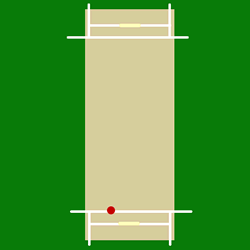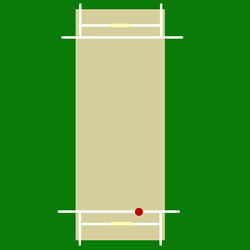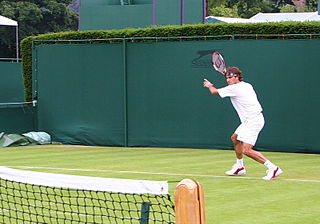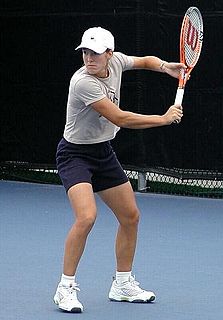See also
| This disambiguation page lists articles associated with the title Topspinner. If an internal link led you here, you may wish to change the link to point directly to the intended article. |
A topspinner is a type of delivery bowled by a cricketer bowling either wrist spin or finger spin.
A topspinner is a type of delivery bowled by a cricketer bowling either wrist spin or finger spin. In either case, the bowler imparts the ball with top spin by twisting it with his or her fingers prior to delivery. In both cases, the topspinner is the halfway house between the stock delivery and the wrong'un - in the wrist spinner's case his googly, and in the finger spinner's case his doosra.
Topspinner may also refer to:
| This disambiguation page lists articles associated with the title Topspinner. If an internal link led you here, you may wish to change the link to point directly to the intended article. |

Badminton is a racquet sport played using racquets to hit a shuttlecock across a net. Although it may be played with larger teams, the most common forms of the game are "singles" and "doubles". Badminton is often played as a casual outdoor activity in a yard or on a beach; formal games are played on a rectangular indoor court. Points are scored by striking the shuttlecock with the racquet and landing it within the opposing side's half of the court.

Leg spin is a type of spin bowling in the sport of cricket. A leg spinner bowls right-arm with a wrist spin action, causing the ball to spin from right to left in the cricket pitch, at the point of delivery. When the ball bounces, the spin causes the ball to deviate sharply from right to left that is, away from the leg side of a right-handed batsman. The same kind of trajectory, which spins from right to left on pitching, when performed by a left-arm bowler is known as left-arm orthodox spin bowling.

Left-arm orthodox spin also known as Slow Left Arm Orthodox spin bowling is a type of Left Arm Finger Off spin bowling in the sport of cricket. Left-arm orthodox spin is bowled by a left-arm bowler using the fingers to spin the ball from right to left of the cricket pitch.

Table tennis, also known as ping-pong, is a sport in which two or four players hit a lightweight ball back and forth across a table using small rackets. The game takes place on a hard table divided by a net. Except for the initial serve, the rules are generally as follows: players must allow a ball played toward them to bounce one time on their side of the table, and must return it so that it bounces on the opposite side at least once. A point is scored when a player fails to return the ball within the rules. Play is fast and demands quick reactions. Spinning the ball alters its trajectory and limits an opponent's options, giving the hitter a great advantage.

A leg break is a type of delivery in the sport of cricket. It is a delivery of a right-handed leg spin bowler.
In tennis, a grip is a way of holding the racquet in order to hit shots during a match. The three most commonly used conventional grips are: the Continental, the Eastern and the Western. Most players change grips during a match depending on what shot they are hitting.

The forehand in tennis and other racket sports such as table tennis, squash and badminton is a shot made by swinging the racket across one's body with the hand moving palm-first. In tennis, except in the context of the phrase forehand volley, the term refers to a type of groundstroke—a stroke in which the ball has bounced before it is struck. It contrasts with the backhand, the other type of groundstroke. For a right-handed player, the forehand is a stroke that begins on the right side of the body, continues across the body as contact is made with the ball, and ends on the left side of the body. It is considered the easiest shot to master, perhaps because it is the most natural stroke. Beginners and advanced players often have better forehands than any other shots and use it as a weapon.

The backhand is a tennis shot in which one swings the racquet around one's body with the back of the hand preceding the palm. Except in the phrase backhand volley, the term refers to a groundstroke. It contrasts with the other kind of groundstroke, the forehand. The term is also used in other racquet sports, and other areas where a similar motion is employed.
In tennis, there are a variety of types of shots which can be categorized in various ways. The grip you place on will help you have different types of shots, the lower your grip means that the ball is most likely going to be a ground stroke. According to William T. Tilden, "All tennis strokes, should be made with the body' at right angles to the net, with the shoulders lined up parallel to the line of flight of the ball ." The serve is the opening shot of a point. Groundstrokes are hit after the ball has already bounced, and can be either forehands or backhands depending on which direction the racket is swung relative to the body. A lob is a groundstroke hit well over the head of an opponent who is positioned at the net. A passing shot is a groundstroke that is hit out of reach of an opponent at the net far to his left or right. A cross-court shot is a shot hit from the left side of one player's court to the left side of the other player's court, so that it crosses the lengthwise centerline of the court. A down-the-line shot is one that is hit more or less parallel to, and near to, one of the sidelines, so that it never crosses the centerline.

Wrist spin is a type of bowling in the sport of cricket. It refers to the cricket technique and specific hand movements associated with imparting a particular direction of spin to the cricket ball. The other spinning technique, usually used to spin the ball in the opposite direction, is finger spin. Wrist spin is bowled by releasing the ball from the back of the hand, so that it passes over the little finger. Done by a right-handed bowler, this imparts an anticlockwise rotation to the ball, as seen from the bowler's perspective; a left-handed wrist spinner rotates the ball clockwise.

In racquet sports and golf, backspin, is a shot such that the ball rotates backwards after it is hit. This direction of spin imparts an upward force that lifts the ball. While a normal hit bounces well forward as well as up, backspin shots bounce higher and less forward. Backspin is the opposite of topspin.
Hardbat table tennis is the classical table tennis playing style that existed prior to the advent of sponge rubber in the 1950s. The main difference between hardbat and modern table tennis lies in the racket used, which greatly affects the dynamics and strategy of the game. Hardbat rackets use short outward "pips" with no sponge, resulting in decreased speeds and reduced spin compared to rackets using sponge rubber. This results in slower shots, and a more strategic game rather than the fast paced, heavy topspin attacking style that dominates regular table tennis.
In cricket, a slider is a type of delivery bowled by a wrist spin bowler. While a topspinner is released with the thumb facing the batsman, a slider is bowled in a similar manner to a legbreak, but instead of imparting sidespin with the third finger, the bowler allows his fingers to roll down the back of the ball, providing a mixture of sidespin and backspin. Whereas a topspinner tends to dip more quickly and bounce higher than a normal delivery, a slider does the opposite: it carries to a fuller length and bounces less than the batsman might expect. The sliders will typically head towards the batsman with a scrambled seam. This has less effect on the flight and bounce but absence of leg spin may deceive the batsman. Frequently the slider is bowled with a mixture of side spin and backspin. This has the effect of making the ball harder to differentiate from the leg break for the batsmen without reducing the mechanical effects caused by the backspin. This delivery may skid straight on or it may turn a small amount.
In tennis, the strings are the part of a tennis racquet which make contact with the ball. The strings form a woven network inside the head of the racquet. Strings have been made with a variety of materials and possess varying properties that have been measured, such as dynamic stiffness, tension retention, thickness (gauge), string texture, and rebound efficiency.
In sports, topspin is a property of a shot where the ball rotates as if rolling in the same direction as it is moving.

A serve in tennis is a shot to start a point. A player will hit the ball with a racquet so it will fall into the diagonally opposite service box without being stopped by the net. Normally players begin a serve by tossing the ball into the air and hitting it. The ball can only touch the net on a return and will be considered good if it falls on the opposite side. If the ball contacts the net on the serve but then proceeds to the proper service box, it is called a let; this is not a legal serve in the major tours although it is also not a fault. Players typically serve overhead, but serving underhand, although rare, is allowed. The serve is the only shot a player can take their time to set up instead of having to react to an opponent's shot. But as of 2012, there is a 25-second limit to be allowed between points.
Michael Fishbach is a former professional tennis player from the United States.